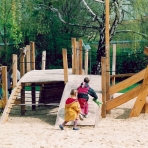Our task was to develop an open structure. Owing the island location and the playground equipment that had graced the area before, once again, a ship was envisioned. This time, however, it was to be very abstract and dynamic in form. Keeping the ship rather abstract would encourage children to use their own imagination during play and also consider non-related play options. We developed the basis for the construction design in a model made of 55 pieces of composite lumber arched at the same radius.
As oak wood composite lumber could not be used here, we chose larch wood for the basic material. Supporting the composite lumber in the ground was then done using oak wood, which is assembled to the composite lumber by straight halving and then screwed down.
The wooden flooring and supporting posts are made of oak. A discreet color tone was requested as the wood itself was to be of central focus. The wood surface was oiled. And, as a contrast to the former ship’s light wood-tone, we opted for black rope. Shiny aluminum orbs were used for the knot joints. A Berlin-based rope factory provided the material.
The floor plan is quite unusual. For safety purposes the ship was divided into two parts that are interrupted by an open space in the middle. The ship’s bow, with its high level of negotiating difficulty, is reserved for older children (ca. 8 to 14 years). The climbing entries serve to limit access to older kids as they can be tackled only by these. The ship’s stern is meant for smaller children (ca. 3 to 8 years). Here, all areas are easily accessible. The large open space serves as a time buffer that allows for adequate reaction time for supervising adults, for example, when a smaller child attempts to enter the area for older kids.
Forging a connection to the outlying areas is a gently swaying footbridge and a sandstone harbor basin equipped with a water pump. The artists group “Steinzeichen” from Potsdam carried out the sandstone work.

- Year of construction 2001
- Location Potsdam BUGA 2001, Freundschaftsinsel
- Design Zimmer.Obst GmbH





















